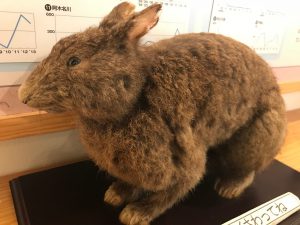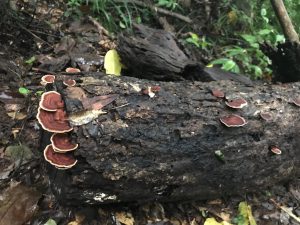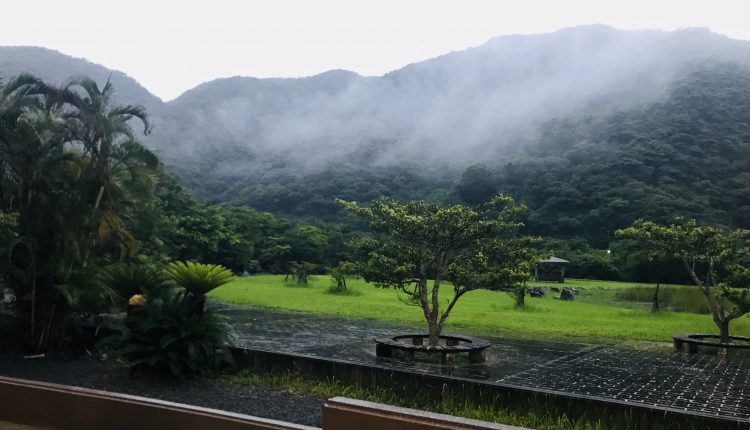Learning of Amami Oshima ~ Minami Neeley
Amami Wildlife Center 6/17

Deep in the green mountains, along a long and winding road you’ll find the Amami Wildlife Center. It’s not an extraordinarily extravagant facility, but it has a certain inviting atmosphere to it. Ready to welcome us in are two of the Wildlife Center workers, and they lead us into an inner presentation room. There were greeted by several key and interesting figures.
First, Mr. Chiba, who works as a forest ranger in the neighboring mountains, perpetually monitors the precious flora and fauna of the island. Amami Oshima was, in fact, once part of the Eurasian continent that split off from land some 2 million years ago. The islands that broke off from Asia formed the Ryukyu archipelago, and because of that Amami is the home of many creatures that have since gone extinct on the mainland and thus can only be found on the islands. 3,000 mm of annual rainfall maintains the subtropical climate, with flourishing mangroves and rainforest the perfect safe haven for all manner of exotic creatures that are only found right here.
Quite fascinating is the way islanders tell the changing of the seasons. In Amami, the villagers and nature live harmoniously, and by watching the birds, insects and animals are able to distinguish when one season fades gives way to the next. In the spring, the Lidth’s jay, the Amami thrush, the Amami woodcock and the Owston’s white-backed woodpecker are the most active. The Amami thrush’s chicks leave the nest after only two weeks and venture the forest underbrush with their parents. The chirps of these birds herald in the season. With summer comes a whole new array of wildlife. The ruddy kingfisher, fiddler crabs, loggerhead

turtles, the Amami spiny rat, and the Amami black rabbit are just a few of the extremely rare animals that emerge as spring gives way to summer. The Amami black rabbit is particularly interesting as the parents live in different dens from their young and only check on them once in two days. After nursing, they seal the hole to their young’s den to protect them from dangerous predators like the habu snake.
Next, Mr. Matsuda of the Mongoose Busters explained to us the very unique situation faced by the black rabbits in Amami. Considered a living fossil by many, Amami Oshima is the only remaining habitat for these critically endangered animals. They have been monitored and protected by the local rangers and environmental agencies, however, in 1979, in order to help quell the habu population that was preying on the Amami rabbit, local officials brought in an estimated 30 small Indian mongoose. As snakes and mongoose are mortal enemies in the natural world, experts assumed they would target and hunt the habu on the island. Yet far from helping preserve the ecological balance, the mongoose began to prey on the Amami rabbit, the Otton’s frog, and other precious indigenous species. The reason for this is speculated to be the fact that their hours of activity do not overlap, as the habu is nocturnal while the mongoose is diurnal. The rabbit population dropped drastically, and even more alarmingly, the mongoose had propagated to some 10,000 by the year 2000. Emergency measures were called for, and in 2005 the official state-sponsored Mongoose Busters were formed. Originally consisting of 12 members, it was their mission to exterminate the mongoose from the island. By using technology like motion cameras, zoning, ingenious traps, detection dogs and more, the busters began to cut down on the mongoose population. Traps were spread every 50m apart, and over 300 monitors were placed throughout the rainforest. Hair traps were used to determine if there was a mongoose present in a certain zone, and the motion cameras would activate and relay to the Busters if there was any mongoose activity. The mongoose were not so easily suppressed, however, and they began to

outsmart and evade the traps. The Busters quickly adapted and introduced a team of detection dogs trained to capture the scent of a mongoose and track it to its den. Terriers are used to track the scent and German shepherds for scat. For mongoose that crept into rock crevices and were impossible to get to, the Busters used smoke to either suffocate them within the rocks or force to come back above ground. The Busters cannot poison the mongoose’s food because it shares much of its diet with other creatures in Amami, and so the Busters use traps, in which 90% of mongoose are killed via the kill trap and the remaining 10% are kept alive and kept at the Wildlife Center for research. Another challenge they faced was in regions with high populations of the Amami spiny rat, which were getting caught and killed by the mongoose traps by accident. To counter this, the group developed a long-barreled trap that wouldn’t harm the spiny rat even if it were to get caught by accident. It is currently believed that only about 50 or so mongoose remain on the island, but because male mongoose cover great distances and move around vast amounts of territory, in 2018 only one mongoose has been captured so far. Due to the mongoose’s astounding proclivity for propagation, the Busters cannot stop until they are absolutely certain every last mongoose has been captured or killed. They started at a mere 12 when they were first established, but now they number 42 experienced members who must have extreme levels of stamina as their everyday work involves hiking all throughout the mountains and setting an average of 60 traps a day. They promote their activities and bring awareness to the mongoose problem via SNS and an internet homepage, and they aim to be the largest example of success in exterminating an invasive, alien species.
What one might not expect when thinking of the wilderness in Amami Oshima are cats. But that’s exactly what Ms. Shionosaki discovered upon researching for her doctoral thesis. She suspects that cats – domestic, stray and feral – may have far more of an impact on the endemic species than the mongoose. As the number of mongoose have declined in recent years, monitoring projects have shown an increasing number of cats within the forests, some video footage even showing cats killing the Amami black rabbit. Furthermore, much like the mongoose, cats have a high reproductive rate, with an average of four kittens per litter and up to three litters a year. Endemic species like the Amami rabbit that have evolved in environments without natural predators, with the notable exception of the habu, typically lack defense and adaptive skills. Thus the normal house cat has proven to be one of the worst predators for the Amami rabbit to face. Ms. Shionosaki became the pioneer in cat researchers in Amami when she set up 180 automatic infrared cameras every 100m. With the data collected from her research, a 10-year plan to remove the feral cat population from the island has been put into motion, slated to commence in the summer of 2018. There are an estimated 800-1200 feral cats living within the forest in Amami, and the plan involves capturing all of them alive and moving them to a care facility where they will be put up for adoption. Several issues entailed with that are the fact that feral cats are like any other wild animal, making them mistrustful and at times aggressive toward humans. Unfortunately, those cats not adopted within a certain period of time would have to be put down. As cats have a generally cozy, household image, many people were against the implementation of this management plan and therefore certain concessions – no-kill traps, kept at a care center and offered for adoption – were made to appease the populace. All domestic cats will be required to be microchipped so that officials will be able to distinguish between pets and the wild felines. Awareness is being brought to this issue by people like Ms. Shionosaki, who has published her research and regularly holds symposiums around Japan, and the cat cafes in Amami that provide information on cats and the current situation on the island.
The last informational seminar on the first day of our trip was given by the Amami ranger office, under the Ministry of the Environment. Established in 2000, it only had 8 staff members in a tiny, outdated little office. In 2014, it received a much-needed renewal, and the Amami Wildlife Center was opened to the public with newer and more various exhibitions. Rangers’ duties include research and surveys, endangered species conservation, the mongoose control project, and national park management.
Some detailed information on Amami Oshima, provided to us by the rangers:
Area: 712 km²
Population: 67,199 (as of 2016)
Average Temperature: 21.6°C
Annual Average Precipitation: 2,837mm
Highest Peak: Mt. Yuwandake at 694m

Unique characteristics of Amami Oshima include large, steep mountains, mangroves, evergreen broadleaf forests, and a wide variety of epiphytes found in the humid forests and along the rives. In 1974, Amami was classified as a sort-of quasi-national park, but due to it being the habitat for countless rare and endangered species, it was recently re-designated as a full-on national park. A national park is not a widely-known concept in Japan, and as a result, the island has seen an increase in tourism. Of course, as a consequence of increased human traffic, certain areas of the island have been overused and abused, and it is the current responsibility of the rangers to ensure no further damage is done and to enact preservation efforts. Furthermore, they bring shine spotlights on lesser-known aspects of the island. For example, in order to bring awareness to the number of incidents of Amami rabbit roadkill (182 confirmed cases from 2000 to 2017), they created decals for cars to warn drivers to take care when driving on roads near forests where the rabbits live.
Mangroves and Amami Rainforest 6/16
The next day, we faced heavy rain from the incoming typhoon, but we nevertheless decided to brave the mangrove forest. Dressed in several layers of water-proof clothing from head to toe, we all looked like very colorful Teletubbies holding massive oars. Heading downstream was quite easy, and the rain even let up a little as we got into the mangrove forest. Our tour guide explained the ecology behind the mangroves and how it is the home to many fascinating creatures and pointed out the crabs that were nearly invisible to spot on the bark of the trees. Even when we weren’t paddling, the fain current would gradually begin to sweep us away, and we’d have to constantly correct ourselves so as not to run into fellow classmates. As we emerged from the mangroves back into the main, large river, the wind began to pick up and the rain pounded harder. The current, too, began to pull at our canoes much harder, and before we knew it we were all slowly being swept downstream. Following our guide’s advice, we decided to head back, and the journey upstream was a battle of strength and stamina. It seemed for every meter we progressed forward, the current would push us back three. It was all we could do not to get drawn out into open waters, where our guides warned we would be swept all the way out to sea. Our arms ached and the rain fell upon us in sheets, the wind whipping at our hair and throwing water in our eyes, but we finally all made it back to the base in more-or-less one piece, albeit far more bedraggled and soggy than when we began.

After eating lunch provided to us by the cat cafe, we proceeded to the Amami rainforest, where we hiked all the way to the top of the mountain. The tour guides explained the many different varieties of flora and fauna present in the forest, and how they all lived in symbiotic harmony. They also told us in no uncertain terms to not stray from the beaten path, as the underbrush could be hiding a habu waiting to strike. By this time, the typhoon was in full swing, but we could hardly hear or feel it among the protection of the “broccoli forest”. It was incredible how sheltered we were, ensconced in quiet tranquility, and how little affected the inside of the forest was all the while a storm was raging above the eaves. At long last, we made it to the top of the mountain and onto the observation platform, where we were hit with the full force of the strong winds. Though shrouded in fog, it was so easy to see the beauty of the island and imagine what it must look like with clear blue skies and the sun shining brightly overhead.
Oshima Tsumugi and Shimauta 6/18

The last day, we went to Oshima Tsumugi Village and got to experience first-hand how the traditional, intricate weavings are created. It was so fascinating to see how much of nature is incorporated into the process, from the washing of the materials in the silt to the dyeing of the weaves. People will stand out in the hot sun for hours as they wash the threads, hunched over and in what has to be an extremely uncomfortable position. Yet no one had any word of complaint, and if anything, they were some of the happiest people I’d met the entire trip. Their craft is still so deeply steeped in tr

adition, and it was like walking through time seeing them use a loom and hand dyeing each of the threads. The Oshima Tsumugi is such high quality and made with such obvious care, and each of the patterns tell a certain story, with the designs representing aspects of their island culture. They welcomed us and sent us off with joyous 「うがみしょうら〜」and「ありがっさまりょうた」 it truly felt like I had become a member of their charming little community.
At the beach, an elderly couple performed a series shimauta for us, and each carried with it such heartfelt and warm messages of promise. A child thanking the mother, the parents watching as the child grows up, a tale of love. Even as our bus was pulling away to take us back to the airport, they sent us off with a song of good fortune and safe travels, bright smiles on their faces with promises and hopes for our return to the island someday. Never before have I seen a people so happy, a culture so harmonious with the nature it lives in. Amami Oshima is truly a magical place, and I hope I will be able to return to its crystalline shores once more.



